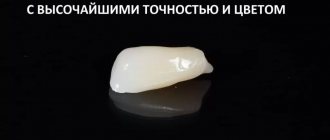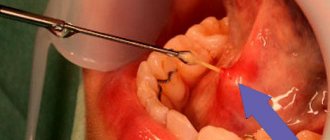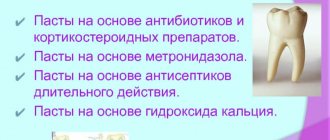Korostelev E.D. Clinic “No Hurt!”
Enlarge
Patients come with the complaint: “Doctor, after eating, the tooth aches for quite a long time, an hour or more, and bleeds after eating, when you brush...”. You examine it - the tooth is healthy, but you start to crawl under the gum, and there you go very deep with the tool. Sometimes it is visible that the gums are swollen and red. This type of toothache occurs especially often on chewing and lateral teeth.
History of toothpicks
The first specially made gold toothpicks appeared 3000 BC in Sumer. However, at all times, starting with the Neanderthals, people have used various devices to clean the space between their teeth. These were stems and pointed sticks of various shapes, but most often nails, the use of which is not very hygienic. Apparently, the problem of cleaning the oral cavity has always worried people, because healthy teeth are always needed. Henry Petroski even published a 450-page book: Toothpick: Technology and Culture. The book describes the history of the creation and development of toothpicks, features of use and the contribution of toothpicks to culture, history and even military affairs. Modern toothpicks
Removing a foreign body from a tooth canal
Removing a foreign body from a tooth canal is a very common dental operation, which, however, requires high qualifications and special skills of the attending physician. With modern equipment, the procedure takes little time and does not cause serious discomfort to the patient.
How does a foreign body get into the tooth canal?
In the vast majority of cases, such a foreign body is a part of an endodontic instrument that breaks off during the treatment of a difficult, too narrow and curved root canal. The cause of breakage may be: a metallurgical defect, repeated use of the tool (the so-called “metal fatigue”), or the doctor’s failure to comply with a certain technique for its use.
What is the danger of a foreign body in the tooth canal?
In most cases, a broken instrument interferes with high-quality filling of the rest of the canal, which is fraught with inflammatory phenomena. Therefore, removing a foreign body from a tooth canal is a necessary operation that must be carried out in a timely manner.
How is a foreign body removed from a tooth canal?
Before removing a foreign body from a tooth canal, the doctor creates direct access to it by drilling out the canal. Next, the broken part of the instrument is loosened and freed from the surrounding dentin - ultrasonic equipment is used for this purpose. Then the foreign body is grabbed by the tip with a special tool and pulled out. The unsealed and expanded canal is ready for further treatment procedures.
What are the recommendations after extraction?
As with any other endodontic treatment, after removing a foreign body from the tooth canal, the patient is advised not to eat for the next two hours - during this time the anesthesia continues to operate, so there is a danger of biting the tongue, cheeks or lips. If after the initial visit a temporary filling falls out, you should immediately contact your doctor to prevent infection from entering the root canal. After filling the canals, a control x-ray should be taken as prescribed by the doctor.
What are the possible complications?
If the foreign body is completely removed, complications can only be associated with errors during subsequent procedures, such as perforation of the root wall, underfilling of the canal or, on the contrary, excessive removal of the filling material beyond its limits, etc. These complications are expressed by the appearance of pain in the tooth and swelling of nearby soft tissues. In such cases, re-treatment is indicated.
What are the criteria for quality of treatment?
High-quality removal of a foreign body from a tooth canal requires high qualifications of the attending physician and the availability of specialized equipment. The procedure must be carried out painlessly, competently, quickly and not result in any complications.
Types of toothpicks
There are a huge number of toothpicks, differing in material, shape and impregnation. Even jewelry toothpicks, smelted from precious metals and decorated with precious and semi-precious stones. Main types of toothpicks:
- Wooden toothpicks;
- Plastic toothpicks;
- Metal toothpicks (stainless steel strips, 0.1 mm thick);
- Combination toothpicks.
- Now the science of hygiene has stepped forward, and the best option is a combined plastic toothpick with floss. It is more convenient than dental floss (especially if you are dealing with tough pieces of food) and safer than the wooden counterpart that can be seen in any restaurant or cafe.
Harm from using toothpicks
The main harm that toothpicks can cause is possible damage, injury to the gums and the spread of infection in the oral cavity.
Benefits of using toothpicks
There are not many benefits of using toothpicks. After all, if there is a need to use a toothpick, then you need dental care, and this concerns not only the health of your teeth, but also your gums. After all, the interdental spaces should be cleaned independently, using only mouth rinse.
One of the reasons that food gets stuck between the teeth may be improperly installed fillings or crowns, which also requires prompt dental intervention and treatment, otherwise it threatens the development of serious diseases of the teeth and gums.
To minimize the risks from using toothpicks, use our tips to at least not harm yourself.
Why does food get stuck between treated teeth?
dentistry teethprostheticsemax high-quality dental prostheticscrownstropedic dentistryveneersceramic inlaysprosthetic crownsHollywood smile white teethpearl teethbeautiful smileimplantationwedge-shaped defectsgingival recessiontreatment of children high-quality dentistry baby teeth colored fillings dental implantation Ankylos implantation high-quality implantation without bone tissue augmentation qualified implantation front teeth prosthetics veneers ceramic crowns Imax e.Max zirconium crowns dental prosthetics with crowns depressurization of composite restoration marginal staining re-polishing of fillings professional examination veneer tooth lightening ceramic veneers exclusive prostheticsgold inlayfront tooth single crownDamon bracesimplantTeeth crowdingOrthognathic surgery Victory bracesMEAW technique multi-loop arch IVD Sato meaw orthodonticSplint therapy wedge-shaped defect treatment of a wedge-shaped defect tooth restorationRestoration of teeth re-polishing fillings artistic restorationExtraction of the inlay remove the inlay from the rootAnchor pin preparation for prostheticsadditional canal cyst treatmentProfessional hygiene clean dental treatmentResection of the root apex Apicotomy Retrograde treatmentSingle-stage implantation Tooth implantation ImplantArtistic restoration treatment of caries Teeth cleaning One-stage implantation Ankyloses Implantation of a tooth with a crack cracked root implantation of a front tooth Ranula retention cyst wound removal save tooth tooth preservation alternative to implantation CCPD SST Ankylos Ankylos FDM implant implant wisdom tooth treatment mock-up mock-up prototyping elastics intermaxillary traction braces hygiene products implantation Astra Astra Tech Panov Mikhail Yurievich dental transplantation dental treatment treatment under a microscope treatment under a microscopeCanal treatmentHollywood smiletooth transplantationTooth extrusionTreatment without preparationTreatment without preparationTreatment tool in the tooth canal Panov Mikhail Yurievich tooth saving treatment of canals filling gum recessionSealing fissure resection of the root apexTeeth preservationIntrusionGum recessiontransplantationDental cariesSST
Introduction
A broken instrument in the tooth and one untreated canal is the background to this clinical case, which was encountered in the practice of the German Implantology Center.
A direct participant in the events, the doctor who saved the patient’s tooth, endodontist of the German Implantology Center Melikov Azer Fuadovich, tells about this interesting case, when it was necessary to remove an instrument previously forgotten by one of the doctors from the root of a tooth:
The patient was referred to me by a colleague from another clinic after obturation of 2 root canals of a tooth, to remove a broken instrument during the work. A broken and forgotten instrument in a canal is not good. During the initial CBCT diagnosis, we identified the fact that the broken instrument was located in the root canal.
The fact that an instrument was left
and in this form it was sealed - this is an extremely negative point. But the situation was complicated by the undertreatment of the tooth as a whole, since during the examination a missed 4th root canal was discovered:
The patient was sent to me with a temporary filling, which I immediately removed. Here is a view of the tooth cavity after removing the temporary filling and monitoring the location of the fragment of the broken instrument in the root canal:
It is necessary to evaluate the situation with an open, unfilled canal missed during treatment for the first time. All work of this level is carried out exclusively using a microscope
, about which there will be a short video at the end of the article. In the following image you can see the appearance of the tooth cavity after removing the temporary filling and checking the missed canal before starting work:
Treatment begins with removing the metal fragment
The instrument, which broke and remained in the tooth canal, actually acted as a pin that had to be removed, since inflammation could develop in the tooth canal at any moment. The consequences of such forgetfulness could be the most dire.
The following image shows the restoration of the mesial wall of the tooth, removal of the broken instrument:
After removing the instrument from the tooth canal, we place the fragment on an endodontic ruler to document the size. The length of the metal fragment was as much as 7 millimeters
!
A little about X-ray monitoring during treatment
Such control is mandatory. Especially when treating root canals.
First stage of control
. In this clinical case, we monitor the passage of root canals (with a broken instrument and the previously missed 4th canal):
Monitoring the patency of the root canals after filling and determining the length is carried out using an apex locator - a special electronic device that determines the position of the apical narrowing and allows you to determine the length of the root canal of the tooth.
What does work look like under a microscope
you can see using an apex locator in this short video:
What to do if, due to a violation of contact points, the gums become inflamed and swollen, and the tooth aches and hurts?
Restore correct contacts between teeth with a doctor
It is necessary to restore the correct contacts between the teeth so that food does not slip there. This is not always possible. It happens that even healthy teeth move apart due to mobility, contact is lost and there is no way to restore it.
Most often, contact disruption occurs between filled teeth. The geometry of the teeth changes. First, one tooth was sealed - the geometry of the junction with the adjacent tooth was slightly disturbed, then the neighboring tooth was sealed - the junction with the previously treated tooth was also disrupted. After some time, the filling wears off a little and the contact is completely broken - food slips, the gums are injured, it begins to hurt, and the tooth itself feels like it hurts.
On treated teeth, contact can be restored with a new filling or crown. As a result, food will not get stuck between the teeth, gum inflammation and aching toothache after eating will go away.
Prevention. Irrigator brush and brush versus toothpicks and dental floss
Proper prevention will help relieve redness and inflammation of the gums around the tooth. But for this you need to properly clean these places.
In pharmacies you need to buy special brushes for cleaning the spaces between teeth. Brushes should be selected in size depending on the characteristics of your teeth.
You should have an irrigator at home, with which you can conveniently and safely wash all gum pockets with a strong jet of water.
About the dangers of constantly using toothpicks and floss
Under no circumstances should you clean gum pockets with toothpicks. Using a toothpick can completely loosen the tooth and injure the gums even more. Very often, people break toothpicks and then cannot remove the tip from the gum pocket and resort to the doctor with severe toothache. A toothpick is when you have nothing at hand, for example, in a cafe, you cleaned it a little. You should not pick your teeth with toothpicks at home. If you have a problem with food settling, carry brushes with you. The toothpick is thick, inelastic, and when we pick our teeth with a toothpick, we constantly loosen our teeth. A floss and dental floss are better than a toothpick, but they are still an emergency dental aid that cannot be used all the time. Dental floss is a direct risk of gum injury.
Sections / If a tooth hurts










